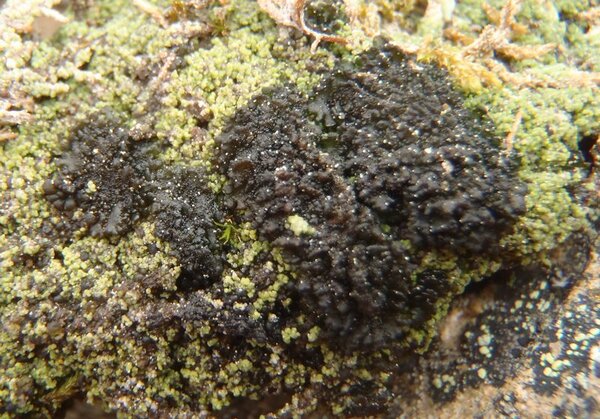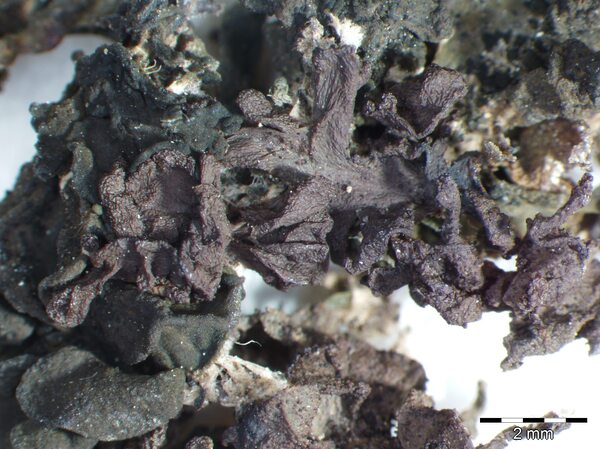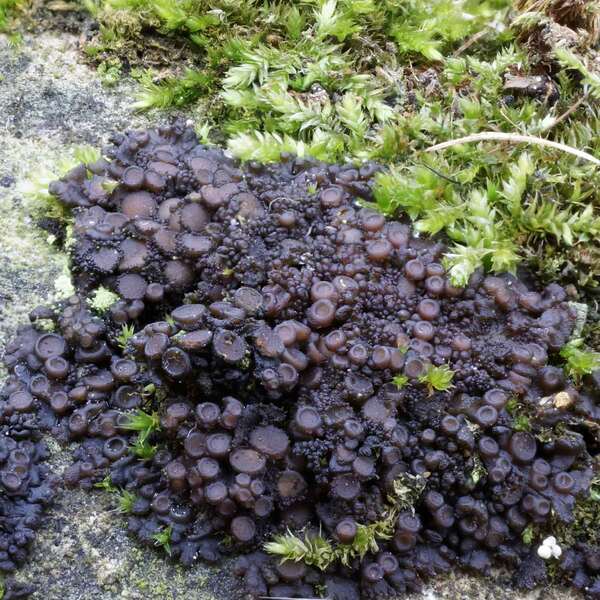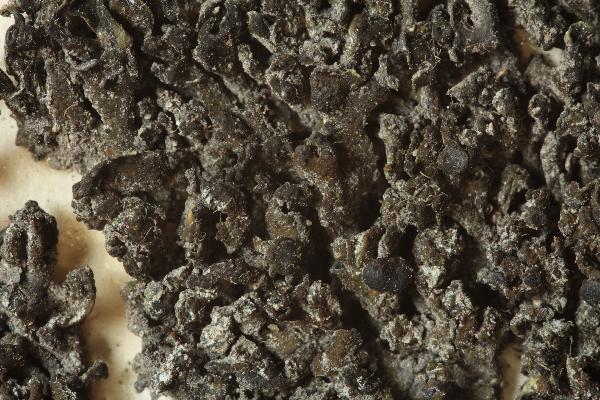Scytinium turgidum (Ach.) Otálora, P.M. Jørg. & Wedin
Fungal Divers., 64, 1: 291, 2013. Basionym: Collema turgidum Ach. - Lichenogr. Univ.: 634, 1810.
Synonyms: Collemodium turgidum (Ach.) Nyl.; Leptogium turgidum (Ach.) Cromb.
Description: Thallus subfoliose, rather thick, markedly gelatinous when wet, the central parts of densely packed, warted to subcylindrical lobes, the margins distinctly lobed, forming regular to irregular rosettes. Lobes small, (0.1-)0.2-1 mm wide and to 2.5 mm long, sometimes ascending and appearing shrubby, especially in central parts of thallus, dark olive-or red-black, somewhat shiny, strongly wrinkled to plicate, with down-turned margins, often densely granular-isidiate, the isidia 60-100 μm in diam. Upper and lower pseudocortex composed of a single layer of angular cells, the layer inbetween of intertwined hyphae and loosely arranged chains of Nostoc. Apothecia absent to numerous, 0.5-3 mm across, with an initially concave, then flat, brown disc and a swollen, entire or slightly granular-isidiate thalline margin. Thalline exciple pseudocorticate; proper exciple paraplectenchymatous; epithecium brownish; hymenium colourless, I+ blue; paraphyses coherent, mostly simple, the apical cells slightly swollen; hypothecium colourless or yellowish. Asci 8-spored, narrowly clavate, the apex strongly thickened, the apical dome K/I+ pale blue, with a downwardly projecting K/I+ deep blue tubular structure. Ascospores at first 3-septate, then submuriform to muriform, with 4-5 transverse septa and 1(-2) longitudinal septa, hyaline, ellipsoid, often apiculate at one or both ends, (18-)20-34 x (6-)8-13(-15) μm. Photobiont cyanobacterial (Nostoc, the cells in short chains). Spot tests: all negative. Chemistry: without lichen substances.
Growth form: Crustose
Substrata: rocks
Photobiont: cyanobacteria, filamentous (e.g. Nostoc, Scytonema)
Reproductive strategy: mainly sexual
On otherwise dry surfaces with short periods of water seepage after rain
Commonnes-rarity: (info)
Alpine belt: absent
Subalpine belt: absent
Montane belt: very rare
Dry submediterranean belt: very rare
Humid submediterranean belt: very rare
Padanian area: absent
pH of the substrata:
1 2 3 4 5
Solar irradiation:
1 2 3 4 5
Aridity:
1 2 3 4 5
Eutrophication:
1 2 3 4 5
Poleotolerance:
0 1 2 3
Altitudinal distribution:
1 2 3 4 5 6
Rarity
absent
extremely rare
very rare
rare
rather rare
rather common
common
very common
extremely common
Loading data...
Occurrence data
Predictive map

Curtis Randall Björk – CC BY-SA 4.0
British Columbia, Rocky Mountains, Bullmoose Mountain, near Tumbler Ridge Date: 2014-06-07 Terricolous on cliff ledge, subalpine

Harrie Sipman – Source http://www.bgbm.fu-berlin.de/sipman/Zschackia/AegeanLichens/CaloplacaAC.htm - As Caloplaca oasis
Growth form: Crustose
Substrata: rocks
Photobiont: cyanobacteria, filamentous (e.g. Nostoc, Scytonema)
Reproductive strategy: mainly sexual
On otherwise dry surfaces with short periods of water seepage after rain
Commonnes-rarity: (info)
Alpine belt: absent
Subalpine belt: absent
Montane belt: very rare
Dry submediterranean belt: very rare
Humid submediterranean belt: very rare
Padanian area: absent
pH of the substrata:
| 1 | 2 | 3 | 4 | 5 |
Solar irradiation:
| 1 | 2 | 3 | 4 | 5 |
Aridity:
| 1 | 2 | 3 | 4 | 5 |
Eutrophication:
| 1 | 2 | 3 | 4 | 5 |
Poleotolerance:
| 0 | 1 | 2 | 3 |
Altitudinal distribution:
| 1 | 2 | 3 | 4 | 5 | 6 |
Rarity
absent
extremely rare
very rare
rare
rather rare
rather common
common
very common
extremely common
Loading data...
Occurrence data
Predictive map

Curtis Randall Björk – CC BY-SA 4.0
British Columbia, Rocky Mountains, Bullmoose Mountain, near Tumbler Ridge Date: 2014-06-07 Terricolous on cliff ledge, subalpine










